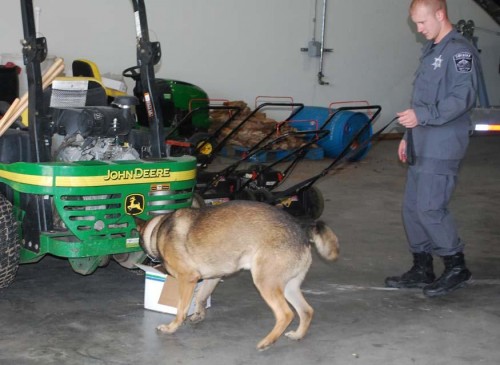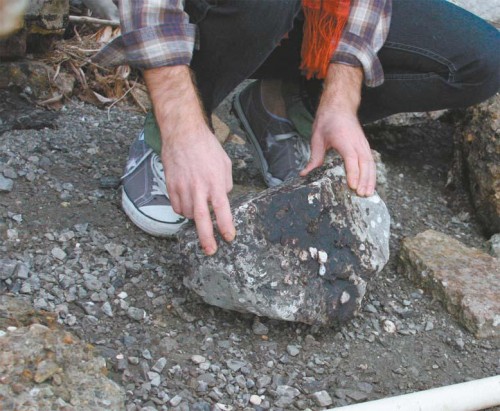Benjamin Spoon
January 14, 2011
Meet Ciro, TPSO’s new bomb-detection dog
January 18, 2011Tar balls seen coming ashore on Elmer’s Island and sheen from what appears to be new oil deposits at Grand Isle are a matter of concern, but not surprising, according to regional government officials or environmentalists working to restore coastal areas.
WDSU-TV and WDSU.com out of New Orleans reported last Wednesday that an environmental cleanup group known as Louisiana Bucket Brigade, had observed the new oil deposits and called the spotting of tar balls “the worst instance of oil contamination since the BP oil spill.”
“We’re not [actually] out on Elmer’s Island. You’re still not allowed to go out to Elmer’s Island. I was just across the channel from Elmer’s Island,” Peter Brabeck, an environmental monitor for the Louisiana Bucket Brigade told the Tri-Parish Times.
Brabeck said he spotted tar balls, stains and oil sheens while on the shore at Grand Isle, where he was responding to residents who claimed that oil from the BP Deepwater Horizon explosion and spill last spring had not been properly cleaned.
“In fact, there are oil markings very clearly on the rocks and weathered oil in the sediments,” he said. “The public beach, which is open in Grand Isle, you can’t walk down the beach without stepping on tar balls. I haven’t seen that quantity of tar balls washing up since shortly after the well was capped.”
Brabeck admitted that there are instances when old oil from under the sand can surface after tides rise and fall over a period time, but said his experience and tendency to “try and give the benefit of the doubt” indicate that the deposits are new.
Scientists had warned that underwater plumes still exist following cleanup efforts and would surface for years following the spill. Brabeck said what he has witnessed suggests that plumes might be behind this situation.
“I found tar balls that were not as weathered as they have been in the past. The quantity of tar balls is increasing as well as the size,” Brabeck said. He added that the pier at Grand Isle State Park offers a view of black water. “This is not the same oil coming up from tide washes,” he said. “I spend a lot of time in Grand Isle and I haven’t seen the oil look like this since the well was capped. There is a visible sheen on the water.”
A day after the WSDU report was given, unconfirmed reports from Port Fourchon said that new tar balls were seen there as well. “Any new tar balls is old stuff that was covered by sand,” said Lafourche Parish public information officer Brennan Matherne.
Terrebonne Parish President Michel Claudet said there is close monitoring of the coastline and marshes and had not heard of any new tar balls being seen. “As of [Friday] I have no additional reports of tar balls in Terrebonne. However, we do anticipate there will be occurrences over the next year or so and [parish director of homeland security] Earl Eues is in constant contact with BP and the Coast Guard if there are changes in our current situation,” he said.
Telephone messages left for Grand Isle Mayor David Camardelle were not returned.
On Dec. 30, 2010, the New Orleans Times-Picayune reported that 113 miles of Louisiana coastline were under active cleanup, with 55 miles waiting to be approved for cleaning. Shoreline Cleanup and Assessment Teams had reportedly cleaned 72 miles of coast to the point that oil could no longer be seen. However, SCAT statistics show that there is another 2,846 miles of beach and wetlands that no longer have visible indications of oil or are not treatable.
“How long are we going to be dealing with this? No one knows,” said Kim Chauvin, owner of Mariah Jade Shrimp Co. in Chauvin. “You’re not getting away with wave a magic wand over the Gulf and everything gets done. It was a nice scenario BP was trying to create with their commercials, but I don’t think any of us are stupid. I have e-mails dating back months ago saying there is no way there are no tar balls. Their thing is to stick their head in the sand and pretend nothing happened.”
Regional observers and leaders said that reports of additional oil being present is not surprising and only reveals that cleanup efforts are not complete.
“The oil they are seeing in Grand Isle, it could be older oil that has resurfaced because of weather conditions,” said Curtis Thomas, BP director of government and public affairs. “Or it could be tar mats that have washed up because of the tide.
“Regardless, our cleanup crews have not left Grand Isle, and we have teams that go out and look for tar balls and then report them. Then are cleanup crews and processes are in place to go and remove those tar balls,” he said.
Thomas said BP has expected all along to see more tar balls surface.
“We fully expect that we are going to see some more oiling of beaches and that’s why we haven’t gone anywhere and made the commitment to stay there until it is cleaned up,” he added.
Members of the Louisiana Bucket Brigade show evidence of new oil deposits found while monitoring conditions at Grand Isle. COURTESY PHOTO








